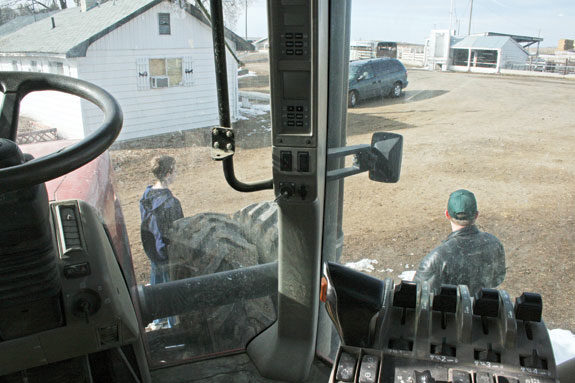I know a boy and a father that were killed in rollovers, a boy that was wrapped up and killed in a PTO and another guy that had his arm messed up in a PTO. I barely pulled a small boy out of the way of the tractor his father was driving. The father didn’t know his son had followed him out and was standing in front of the tractor. There are many such cases and accidents that change families all over the country because someone wasn’t careful or aware of their surroundings. Safety is an often overlooked aspect of equipment management. However, it’s a topic that can have major consequences on you, the operator and your business.
Visibility
When sitting in the cab of your tractor, how much of the ground right around you can you see? Visibility can be very limited in some pieces of equipment. The large wheels on tractors can do a lot of damage to an individual or building, not to mention the tractor, if the tractor’s full width isn’t accounted for. If you put an implement on the back, carelessness can turn into emergencies very quickly.
Warning signs
Did you know that by taking off the shields and warning stickers, you can be held liable for injuries suffered by others? I have been a witness in court for a case where a dealer removed a shield over the PTO because it was bent up and sold it that way. When the unguarded PTO caused an injury, the dealer was at fault for selling an unsafe piece of equipment. I have also heard of cases where farmers are sued when a worker is hurt, for taking off caution/warning stickers on potentially hazardous parts of the machine. They are there for the protection of the operator and should be left on the machine.

Read and follow the label
I was asked to work on a neighbor’s tractor that wouldn’t start. It was getting late and I failed to get into the cab to make sure the tractor wasn’t in gear or that it was in park. I checked the battery with a voltmeter and it was fine. I set down the voltmeter and moved some wires to get a better look. The wires were old and frayed and the black, plastic safety cover was broken off, so when I moved the wires the S-terminal wire touched the battery cable terminal and started the engine. The tractor was in reverse and it ran into a ditch. Luckily it fell over in the ditch and I was able to shut it off. Also lucky for me was that the wheels were turned a little bit and I wasn’t hit. If the tractor had been in another gear and gone forward, I wouldn’t be here today. Always make sure the tractor is in park and never bypass the neutral safety switch. When dealing with starters and running engines, have someone in the cab that knows what to do if the tractor starts moving. Covers and warning labels are there for your protection, not necessarily your convenience.
Operation
According to some reports, about 200 [farming] fatalities occur in the U.S. each year due to rollovers. According to the National Ag Safety Database, 52 percent of fatal farm accidents are caused by rollovers. Falls, hitching accidents, entanglements and run-over accidents can cause serious injury and even death. Many of these accidents happen because operators are either careless, not trained well or distracted. Be mentally where you’re at when you are there, not somewhere else. Driver distractions caused 6,000 deaths last year and 500,000 injuries in 2008 alone. The same risks apply to driving a tractor. Be present and focused on the job you are doing and don’t take risks.
Take time to walk around the equipment before driving off, so you can be sure no one, or nothing will be hurt. Turn off equipment before working on it, when at all possible. Use protective eye and ear wear, even if it seems uncomfortable or uncool. Make sure your employees and operators are safe with the equipment and properly trained. Safety is everyone’s job. PD
Send in your mechanical questions to ryan@progressivedairy.com to have them answered in this column.
PHOTOS : When sitting in the cab of your tractor, how much can you really see? Above right is what the operator of the tractor would see and above left we see who the operator can't see. Make sure you check before you drive. Photos by Ray Merritt.

-
Jim Schlund
- Retired Diesel
- Mechanics Professor
- College of Southern Idaho





